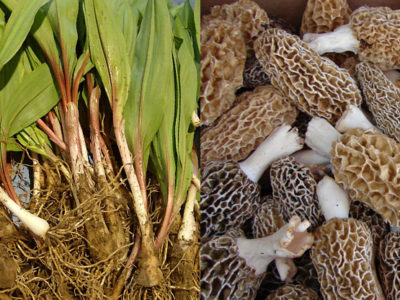It’s the time of year where I start keeping my eye out for giant puffball mushrooms in my yard. I’ve still got some wild onions to pick, and even a few dandelions and wild strawberries can be seen among the weeds in my flowerbed.
If you’ve ever picked juicy, sun-ripened blackberries out in the forest, or come across a vine of wild muscadine grapes, then you know the magic of wild edibles. They’re bursting with flavor, as fresh as food can be, and absolutely teeming with nutrition! And best of all, they’re a free resource available to practically all of us—once we know what to look for.

I grew up foraging. We were very poor, and much of our food came from what we could grow in our yard, fish or pick from the ocean (one of many benefits of growing up by the ocean), and collect from woods, road sides, and unmaintained parks in our neighborhood. As a 5-year old, I knew at least six types of berries, three types of edible mushrooms, a couple of edible wild roots, and at least five types of edible flowers, including the ubiquitous dandelion flowers, buds and greens. While foraging came out of necessity during my childhood, I do it now for an appreciation of the unique flavors and unmatched nutrients these foods contain.
Although the types of wild edibles available to you will depend on a host of factors (geography, climate, altitude, and season, just to name a few), it’s usually possible to find at least a few different wild items without even leaving the neighborhood. So why wait? Let’s learn about these nutritional gems so we can start incorporating them into our diets!
Why Bother Foraging for Food?
Many of us have super busy lives and limited time to prepare our food, much less go outside and gather it with our own hands. But, collecting wild edibles is a hugely rewarding experience, not only for the sense of accomplishment (and the perks that come from getting outside in fresh air and nature), but also for the incredible nutritional benefits foraged foods bring.
Studies of wild foods almost universally show that they’re higher in micronutrients than their cultivated counterparts (especially vitamin C, copper, calcium, sodium, potassium, and iron). In fact, hunter-gatherers and free-living primates (whose plant-food intake is 100% wild) can achieve intakes of certain vitamins and minerals that would be impossible for most of us to reach on a cultivated-food diet, unless we were also taking supplements. For instance, even without dairy, it’s estimated that early humans consumed about twice as much calcium as we do today (thanks in large part to a diverse intake of nutrient-dense foraged plants)!

Plus, wild foods tend to be incredibly high in nonessential (but highly beneficial!) phytochemicals. Because wild foods don’t have the assistance of external pesticides, herbicides, fungicides, greenhouses, or other man-made structures to protect them from predators, it forces the plants to ramp up their own innate defense systems—including producing secondary metabolites like polyphenols, phenolic acid, flavonoids, organosulfur compounds, phytic acid, tannins, isothiocyanates, and other compounds that help protect plants from pathogens and predators. And, as we explored in my previous posts on phytochemicals (here) and polyphenols (here), those same compounds offer an incredible array of benefits for us humans, too. (Reduced cancer risk? Protection against DNA damage and oxidative stress? Reduced inflammation? Hormonal regulation? Yes please!)
So, what easy-to-find wild foods can give us these micronutrient and phytochemical benefits? Let’s take a look at some of the most common varieties!
Wild Greens
The idea that we have to pay a lot of money for high-quality organic greens is really a myth. In most regions, we only have to wander around the block to find a patch of delicious, nutrient-dense wild greens to throw into our salads, pestos, side dishes, and other kitchen concoctions, for absolutely free. For example, check out these frequently-spotted varieties:
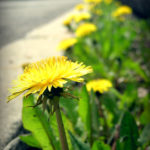 Dandelion. What do dandelions give us apart from extra yard work? Tons of nutrition, for one! A single cup of dandelion greens contains 535% of the RDA for vitamin K, 112% for vitamin A (in the form of vitamin A precursors), 32% for vitamin C, and about 10% for vitamin E, calcium, iron, and manganese. And, the buds and yellow flowers are edible, too. Not too bad for a plant most of us want to get rid of!
Dandelion. What do dandelions give us apart from extra yard work? Tons of nutrition, for one! A single cup of dandelion greens contains 535% of the RDA for vitamin K, 112% for vitamin A (in the form of vitamin A precursors), 32% for vitamin C, and about 10% for vitamin E, calcium, iron, and manganese. And, the buds and yellow flowers are edible, too. Not too bad for a plant most of us want to get rid of!
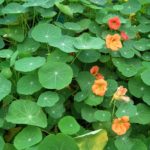 Nasturtium. These plants have edible, peppery-tasting leaves and flowers, and are a great addition to salads or pickled foods. Rich in vitamin C and iron, they frequently grow in city and suburban environments (and are often used in gardens, since they can help protect other plants from predatory insects). I almost always have a few nasturtium plants planted in my yard just for the beauty of the flowers in salads!
Nasturtium. These plants have edible, peppery-tasting leaves and flowers, and are a great addition to salads or pickled foods. Rich in vitamin C and iron, they frequently grow in city and suburban environments (and are often used in gardens, since they can help protect other plants from predatory insects). I almost always have a few nasturtium plants planted in my yard just for the beauty of the flowers in salads!
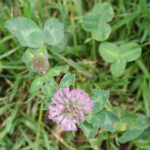 Clover. Clovers are a common sight in backyards and natural areas in most parts of the US. The entire plant—leaves, roots, and blossoms—is edible (although the flowers are the most palatable for most people), and clover is rich in calcium, magnesium, chromium, niacin, phosphorus, potassium, vitamin C, thiamine, and isoflavones. (In fact, ongoing research is studying the effects of clover isoflavones on osteoporosis, menopausal symptoms, cancer, and cardiovascular disease.)
Clover. Clovers are a common sight in backyards and natural areas in most parts of the US. The entire plant—leaves, roots, and blossoms—is edible (although the flowers are the most palatable for most people), and clover is rich in calcium, magnesium, chromium, niacin, phosphorus, potassium, vitamin C, thiamine, and isoflavones. (In fact, ongoing research is studying the effects of clover isoflavones on osteoporosis, menopausal symptoms, cancer, and cardiovascular disease.)
Nutrivore Weekly Serving Matrix
An easy-to-use and flexible weekly checklist
to help you maximize nutrient-density.
The Weekly Serving Matrix is very helpful! I’ve been eating along these lines but this really helps me know where to focus vs. which foods serve a more secondary role. It’s super helpful and has taken a lot of worry out of my meal planning. Thanks!
Jan
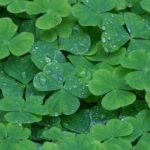 Wood sorrel. Wood sorrel is another edible weed often mistaken for clover (the main difference is that wood sorrel has heart-shaped leaves, like the iconic Irish shamrock, whereas clover has rounded leaves). Growing throughout most of North America, wood sorrel has a lemony flavor and impressive vitamin C content (some varieties of sorrel were used by sailors to avoid scurvy).
Wood sorrel. Wood sorrel is another edible weed often mistaken for clover (the main difference is that wood sorrel has heart-shaped leaves, like the iconic Irish shamrock, whereas clover has rounded leaves). Growing throughout most of North America, wood sorrel has a lemony flavor and impressive vitamin C content (some varieties of sorrel were used by sailors to avoid scurvy).
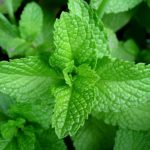 Mint. Mint is a great wild edible because it’s so easy to identify (rub a leaf between your fingers and take a whiff!). Spearmint, peppermint, and other mint varieties can commonly be found growing in yards, between rocks, on hillsides, in fields, and in both rural and urban areas in most regions of the country. And, mint (especially peppermint) ranks high on the list of polyphenol-rich foods, enhancing its already impressive nutrient profile (iron, beta-carotene, folate, vitamin C, calcium, and manganese are abundant).
Mint. Mint is a great wild edible because it’s so easy to identify (rub a leaf between your fingers and take a whiff!). Spearmint, peppermint, and other mint varieties can commonly be found growing in yards, between rocks, on hillsides, in fields, and in both rural and urban areas in most regions of the country. And, mint (especially peppermint) ranks high on the list of polyphenol-rich foods, enhancing its already impressive nutrient profile (iron, beta-carotene, folate, vitamin C, calcium, and manganese are abundant).
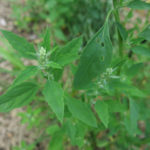 Lambsquarters (wild spinach). A common weed throughout moderate-climate regions, and a staple of my childhood (and adulthood for that matter!) lambsquarter is one of the most nutritious leafy greens known—with even higher levels of beta-carotene, lutein, fiber, vitamin C, calcium, zinc, copper, manganese, and riboflavin than its cousin, domesticated spinach. It’s also up to four times higher in potassium than common green vegetables like Swiss chard and broccoli (with 1286mg per 100 grams, by some analyses).
Lambsquarters (wild spinach). A common weed throughout moderate-climate regions, and a staple of my childhood (and adulthood for that matter!) lambsquarter is one of the most nutritious leafy greens known—with even higher levels of beta-carotene, lutein, fiber, vitamin C, calcium, zinc, copper, manganese, and riboflavin than its cousin, domesticated spinach. It’s also up to four times higher in potassium than common green vegetables like Swiss chard and broccoli (with 1286mg per 100 grams, by some analyses).
Other Wild Vegetables
The list of forage-worthy vegetables doesn’t end with leafy dark greens! Some other common wild vegetables include:
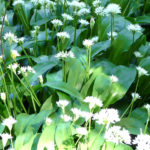 Wild garlic and wild onions. Members of the allium genus (and cousins of the familiar store-bought varieties), wild onions, leeks (called ramps) and garlic are a treasure to find outside—and often, you can smell them before you see them! All parts of the plants are edible (the underground bulbs, the flowers, and the leaves), and like other alliums, they’re rich in anti-cancer allylsulfides and organosulfur compounds.
Wild garlic and wild onions. Members of the allium genus (and cousins of the familiar store-bought varieties), wild onions, leeks (called ramps) and garlic are a treasure to find outside—and often, you can smell them before you see them! All parts of the plants are edible (the underground bulbs, the flowers, and the leaves), and like other alliums, they’re rich in anti-cancer allylsulfides and organosulfur compounds.
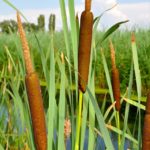 Cattails. Cattails are a common sight in wetlands, pond edges, and even wet gutters along the side of the road. And, they happen to be a great wild edible! Their starchy root (called a rhizome) can be peeled, cooked, and eaten just like a potato, and the corms (small stubs near the cattail’s base) can also be peeled and eaten either raw or cooked. Depending on the time of year, the shoots, flower heads, and hotdog-like pollen heads can also be consumed.
Cattails. Cattails are a common sight in wetlands, pond edges, and even wet gutters along the side of the road. And, they happen to be a great wild edible! Their starchy root (called a rhizome) can be peeled, cooked, and eaten just like a potato, and the corms (small stubs near the cattail’s base) can also be peeled and eaten either raw or cooked. Depending on the time of year, the shoots, flower heads, and hotdog-like pollen heads can also be consumed.
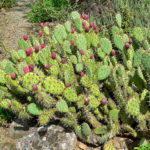 Nopales (prickly pear cactus). Hot, dry climates might seem like hard places to forage, but even the desert is home to wild edibles (great news if you live in the Southwest or other arid areas!). Nopales are a common cactus characterized by flat, oval-shaped pads and oblong fruit (typically reddish purple), with a high content of vitamin C, magnesium, calcium, fiber, copper, and potassium. Both the pads and the fruit are edible once they’ve been de-thorned and peeled. (Warning: nopales are covered in needle-like spikes and smaller spines called glochids, so they’re best gathered with thick gloves!)
Nopales (prickly pear cactus). Hot, dry climates might seem like hard places to forage, but even the desert is home to wild edibles (great news if you live in the Southwest or other arid areas!). Nopales are a common cactus characterized by flat, oval-shaped pads and oblong fruit (typically reddish purple), with a high content of vitamin C, magnesium, calcium, fiber, copper, and potassium. Both the pads and the fruit are edible once they’ve been de-thorned and peeled. (Warning: nopales are covered in needle-like spikes and smaller spines called glochids, so they’re best gathered with thick gloves!)
Wild Mushrooms
Any attempt at collecting wild mushrooms needs to come with a disclaimer! There are many poisonous lookalikes that resemble edible mushrooms (including all those detailed below), and harvesting the wrong kind can quickly result in a hospital visit, a liver transplant, or worse (yeah, I do mean death). If you aren’t an experienced collector and 100% confident about distinguishing safe mushrooms from hazardous ones, there are mushroom-hunting clubs, expert-led expeditions, and even local classes that can offer safe mushroom-hunting adventures without the risk of misidentification.
That being said, wild mushrooms are a fantastic resource rich in protein, fiber, micronutrients, and unique, meaty flavors! Their distinctive tastes and versatility in the kitchen make them well worth the effort to collect. Some favorites among mushroom hunters include:
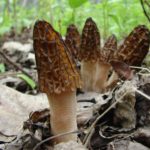 Morels. Morels are distinctive, spongy-looking mushrooms with a nutty, steak-like flavor. 100 grams of raw morels contains 25% of the RDA for niacin, 21% of the RDA for riboflavin, 13% of the RDA for pantothenic acid, 12% of the RDA for phosphorus, 12% of the RDA for potassium, and 12% of the RDA for copper. (They’re available in almost every US state except for Arizona and Florida, and are typically ready to harvest in early spring before the trees leaf out.)
Morels. Morels are distinctive, spongy-looking mushrooms with a nutty, steak-like flavor. 100 grams of raw morels contains 25% of the RDA for niacin, 21% of the RDA for riboflavin, 13% of the RDA for pantothenic acid, 12% of the RDA for phosphorus, 12% of the RDA for potassium, and 12% of the RDA for copper. (They’re available in almost every US state except for Arizona and Florida, and are typically ready to harvest in early spring before the trees leaf out.)
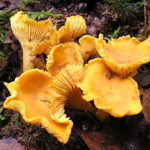 Chanterelles. Chanterelles are a highly prized yellow, trumpet-shaped mushroom with a meaty texture and distinctive flavor. A staple wild edible of my childhood, we would select late summer campsites for family vacations based on proximity to good chanterelle-collecting locations. They contain an impressive amount of niacin, potassium, iron, copper, pantothenic acid, riboflavin, and fiber. They’re also one of the richest sources of vitamin D we know of, with concentrations of D2 as high as 212 IU per 100 grams of raw chanterelle. (Chanterelles are available on the East coast for most of the summer and into the fall, and available on the West coast from September to February.)
Chanterelles. Chanterelles are a highly prized yellow, trumpet-shaped mushroom with a meaty texture and distinctive flavor. A staple wild edible of my childhood, we would select late summer campsites for family vacations based on proximity to good chanterelle-collecting locations. They contain an impressive amount of niacin, potassium, iron, copper, pantothenic acid, riboflavin, and fiber. They’re also one of the richest sources of vitamin D we know of, with concentrations of D2 as high as 212 IU per 100 grams of raw chanterelle. (Chanterelles are available on the East coast for most of the summer and into the fall, and available on the West coast from September to February.)
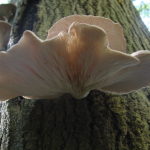 Oyster mushrooms. Wild oyster mushrooms are a goldmine for micronutrients like riboflavin, niacin, pantothenic acid, iron, phosphorus, potassium, copper, manganese, zinc, magnesium, vitamin B6, and selenium! Typically growing on dead hardwood trees in shelf-like formations, these mushrooms are great for wild-edible beginners because they’re easy to identify and don’t have any poisonous lookalikes. (Oyster mushrooms are available year-round and throughout most of the country, but pop up most often in cooler weather.)
Oyster mushrooms. Wild oyster mushrooms are a goldmine for micronutrients like riboflavin, niacin, pantothenic acid, iron, phosphorus, potassium, copper, manganese, zinc, magnesium, vitamin B6, and selenium! Typically growing on dead hardwood trees in shelf-like formations, these mushrooms are great for wild-edible beginners because they’re easy to identify and don’t have any poisonous lookalikes. (Oyster mushrooms are available year-round and throughout most of the country, but pop up most often in cooler weather.)
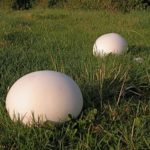 Puffballs. Named because when they’re ready to release their spores, the cap splits and cloud of brown dust-like spores “puffs” out (they’re fun to step on when they’re ready to release their spores too). Most puffballs are edible, although not all. The giant puffball, which grows unbidden in lawns, meadows and deciduous woods across North America (especially where summers are more humid), reaches a foot or more in diameter, and is difficult to mistake for any other fungus. If collected before spores have formed, while the flesh is still white, it may be cooked in a huge variety of ways and has a delightful strong earthy, mushroom flavor. Those that are rich in heart-healthy oleic acid fatty acids, iron, magnesium, copper, potassium, selenium, zinc, B-vitamins, vitamin K and vitamin D2. (Puffballs are another fall harvest mushroom, but are only good before the spores form inside the cap.)
Puffballs. Named because when they’re ready to release their spores, the cap splits and cloud of brown dust-like spores “puffs” out (they’re fun to step on when they’re ready to release their spores too). Most puffballs are edible, although not all. The giant puffball, which grows unbidden in lawns, meadows and deciduous woods across North America (especially where summers are more humid), reaches a foot or more in diameter, and is difficult to mistake for any other fungus. If collected before spores have formed, while the flesh is still white, it may be cooked in a huge variety of ways and has a delightful strong earthy, mushroom flavor. Those that are rich in heart-healthy oleic acid fatty acids, iron, magnesium, copper, potassium, selenium, zinc, B-vitamins, vitamin K and vitamin D2. (Puffballs are another fall harvest mushroom, but are only good before the spores form inside the cap.)
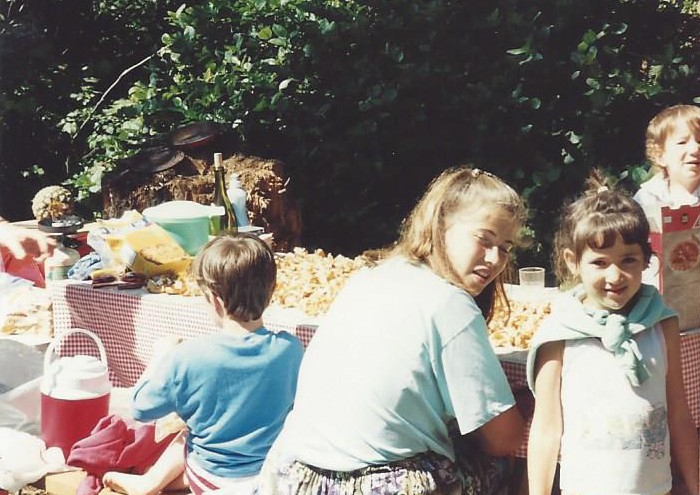
Wild Fruit
Unlike cultivated fruit, which tends to be sucrose-dominated, wild fruits are generally higher in glucose and fructose (as well as fiber) and richer in micronutrients. And, because wild fruit tends to be smaller than their domesticated counterparts, they have a higher skin-to-pulp ratio—giving them greater levels of certain phytochemicals concentrated in the skin. When they’re in season, they’re fantastic foods to forage.
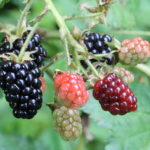 Wild berries. The list of wild edible berries is a long one! Huckleberries, salmonberries, salal, wild strawberries, wild blackberries, wild blueberries, cranberries, mulberries, gooseberries, and wild raspberries, just to name a few. Depending on the region and the time of year, different berry varieties can be growing as weeds in the backyard (think: blackberries), as ornamental shrubbery (like strawberries and salal), near swamps and marshes (like cranberries), along trails in the forest (like salmonberries and huckleberries), and in various other parts of urban, suburban, and rural environments. Although the nutritional profile varies depending on the type of berry, wild ones are generally higher in vitamins, minerals, and phytonutrients than cultivated berries. They pack a punch of flavor that also can’t be beat!
Wild berries. The list of wild edible berries is a long one! Huckleberries, salmonberries, salal, wild strawberries, wild blackberries, wild blueberries, cranberries, mulberries, gooseberries, and wild raspberries, just to name a few. Depending on the region and the time of year, different berry varieties can be growing as weeds in the backyard (think: blackberries), as ornamental shrubbery (like strawberries and salal), near swamps and marshes (like cranberries), along trails in the forest (like salmonberries and huckleberries), and in various other parts of urban, suburban, and rural environments. Although the nutritional profile varies depending on the type of berry, wild ones are generally higher in vitamins, minerals, and phytonutrients than cultivated berries. They pack a punch of flavor that also can’t be beat!
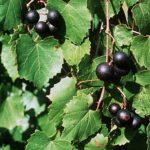 Muscadine grapes. These delicious (but seedy and thick-skinned!) grapes grow wild in well-drained lands, especially in warm, humid environments. They’re rich in a variety of polyphenols, including resveratrol, quercetin, ellagic acid, kaempferol, flavan-3-ols, gallic acid, and proanthocyanidins. And, they’re super high manganese (over 100% of the RDA is in 100 grams of muscadines), along with some copper, potassium, magnesium, and calcium.
Muscadine grapes. These delicious (but seedy and thick-skinned!) grapes grow wild in well-drained lands, especially in warm, humid environments. They’re rich in a variety of polyphenols, including resveratrol, quercetin, ellagic acid, kaempferol, flavan-3-ols, gallic acid, and proanthocyanidins. And, they’re super high manganese (over 100% of the RDA is in 100 grams of muscadines), along with some copper, potassium, magnesium, and calcium.
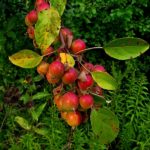 Crabapples. Small and tart, crabapples trees commonly line city streets, drop their bounty into backyards, and cover the ground with fruit in late summer and early fall. And although they’re not as sweet and juicy as cultivated varieties, they’re definitely edible! Crabapples are good sources of vitamin C, potassium, manganese, copper, and fiber, and due to their small size (and higher ratio of skin to pulp), they’re richer than domesticated apples in quercetin, a flavonoid with antihistamine and anti-inflammatory properties.
Crabapples. Small and tart, crabapples trees commonly line city streets, drop their bounty into backyards, and cover the ground with fruit in late summer and early fall. And although they’re not as sweet and juicy as cultivated varieties, they’re definitely edible! Crabapples are good sources of vitamin C, potassium, manganese, copper, and fiber, and due to their small size (and higher ratio of skin to pulp), they’re richer than domesticated apples in quercetin, a flavonoid with antihistamine and anti-inflammatory properties.
Making Them Tasty
Although many wild edibles are delicious as-is, others can have strong, bitter, or overpowering flavors (often due to their high content of certain phytochemicals). In those cases, we can still incorporate wild edibles into recipes to mask or dilute their flavor, creating a truly delicious and nutrient-rich meal. Here are some ideas!
- Substitute nasturtium (or other wild greens) for arugula in Arugula Pesto, Strawberry Arugula Salad, or Apricot and Arugula Salad
- Add cooked crabapples to compotes or chutneys, or use them to make jellies or marmalade
- Use wild foraged mushrooms in Eggplant and Wild Mushroom Stuffing or in a Sausage and Mushroom Frittata
- Add nopales to scrambled eggs, salsa, or stews/soups
- Make spiced pickled crabapples using cooked crabapples, apple cider vinegar, cinnamon, cloves, rosemary, and a sweetener of choice (such as sucanat or date sugar)
- Use your favorite wild berry in Nut-free, Coconut-free Paleo Blueberry Muffins
- Add wild greens, wild garlic, wild onions, and/or wild mushrooms to omelets, soups, stews, and casseroles
How to Get Started
Once it’s time to forage, a huge number of field guides, online tutorials, and region-specific manuals await! Nearby woodlands, parks, forest trails, undeveloped land, vacant lots, marshes, roadsides, and even the backyard are all excellent places to find wild edibles. And, the website http://fallingfruit.org/ offers an interactive map with hundreds of thousands of wild fruit and vegetable locations across the world, making it easy to see what might be around the corner!
If you’re thinking about a walk while the turkey is in the oven this Thursday, think about choosing a location where you may be able to also gather some extra additions for your Thanksgiving meal!
Bottom line
Gathering wild edibles is so worth it. It’s a great way to save money, spend some time outdoors, and boost your diet with an incredible array of micronutrients and phytochemicals—which translates to enhanced disease protection, immunity, and overall better health. What’s not to love?
Citations
Chin A. “Eating Wildly: Foraging for Life, Love and the Perfect Meal.” Simon and Schuster, 2014.
“Crabapples, raw.” United States Department of Agriculture Agricultural Research Service, National Nutrient Database for Standard Reference.
Craft D. “Urban Foraging: Finding and eating wild plants in the city.” Service Berry Press, 2010.
“Dandelion greens, raw.” United States Department of Agriculture Agricultural Research Service, National Nutrient Database for Standard Reference.
Duke JA. “Handbook of Edible Weeds: Herbal Reference Library.” CRC Press, 2000.
Eaton SB, et al. “Paleolithic nutrition revisited: a twelve-year retrospective on its nature and implications.” Eur J Clin Nutr. 1997 Apr;51(4):207-16.
Kallas J. “Wild Edible Plants.” Logan, UT: Gibbs Smith, 2010.
Kious BM. “Hunter-gatherer Nutrition and Its Implications for Modern Societies.” Nutrition Noteworthy. 2002;5(1).
Mabey R. “Food for Free.” HarperCollins UK, 2012.
Milton K. “Back to basics: Why foods of wild primates have relevance for modern human health.” Nutrition. 2000;16(7/8):478-483.
Milton K. “Nutritional characteristic of wild primate foods: do the diets of our closest living relatives have lessons for us?” Nutrition. 1999 Jun;15(6):488-98.
“Muscadine Grape.” California Rare Fruit Growers, Inc. Accessed November 16, 2015.
Nwachukwu ID, et al. “Sulfur and sulfur compounds in plant defence.” Nat Prod Commun. 2012 Mar;7(3):395-400.
“Red clover.” University of Maryland Medical Center. Accessed November 13, 2015.

